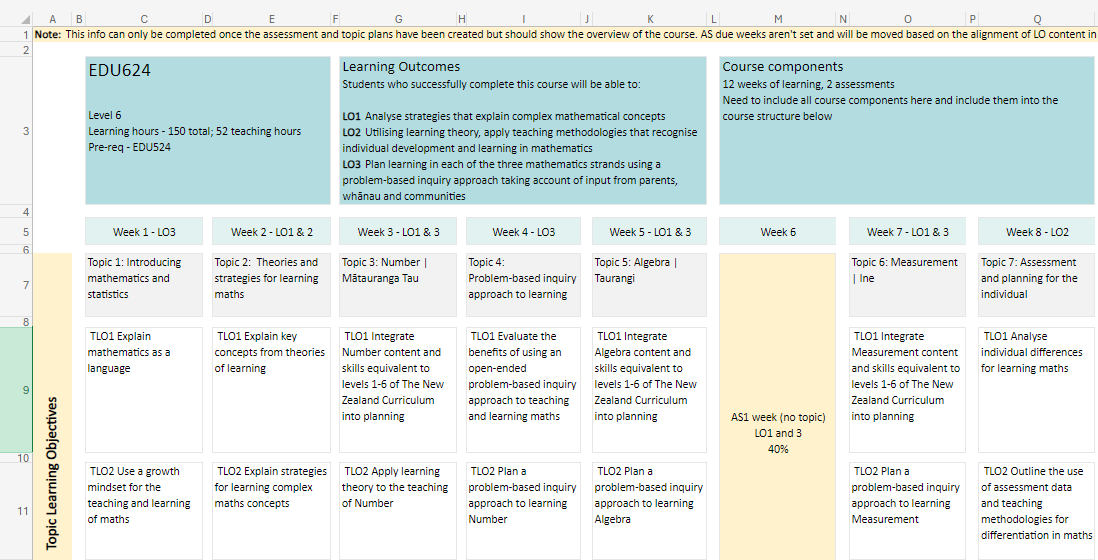Course mapping
A course map provides a high-level outline of a course's delivery structure for the duration of the approved teaching weeks. It should be developed from the Course Level Alignment Table (CLAT) and with assessments already identified.
A course map includes administrative details from the approved course description including:
- Course code and title
- Course purpose/summary
- Learning outcomes
- Indicative content, skills, areas etc.
The key components, course and learning-related content that contribute to the relevance and efficacy of a course map includes:
-
A structured series of topics that cover the skills and knowledge identified in the CLAT, and therefore are aligned to one or more of the course learning outcomes.
-
Strategically scheduled and weighted summative assessments, including a concise description of each assessment's type, content, and objectives. These are designed to evaluate observable evidence or performance as specified in the CLAT. Details on the weighting and frequency of these assessments are outlined in the summative assessment strategy.
Each topic must include:
-
a clear and concise topic title
-
a clearly articulated purpose statement that aligns with the intentions of the skills and knowledge identified in the CLAT and the course learning outcomes
-
one or more clearly articulated, measurable topic learning objectives (TLO) that follow the approved structure (Verb, Content, Context), aligned to skills and knowledge identified in the CLAT and provide a pathway to achieving one or more of the course learning outcomes.
Considerations
Course learning outcome weighting
Learning outcomes may vary in their weighting within a course. Review the Programme Document and Coherence Table to ascertain the specific weighting of each learning outcome. Ensure that the volume, frequency, and depth of the topic learning objectives are appropriately calibrated to reflect the relative importance of each course learning outcome.
Assessments
Assessments are typically designed to evaluate multiple learning outcomes. It is crucial to ensure comprehensive coverage of the learning outcomes in preparation for each assessment event.
Careful consideration should be given to the weighting of assessments to guarantee that the volume of content delivered aligns appropriately with the assessment's requirements. For instance, scheduling an assessment worth 60% in week 5 may be challenging, as it occurs before more than 50% of the course content has been covered.
Topic learning objective volume
Keep the number of Topic Learning Objectives (TLOs) manageable. Having too many can make the course too complex and confuse students, making it hard for them to grasp and apply important ideas. Focus on the most essential knowledge and skills needed to meet the main learning outcomes, and make sure each TLO helps students understand and master these key concepts.
Creating and presenting a Course map
Both Visio and Excel have been popular tools for presenting course maps. However, before diving into the presentation tool, it's best to identify and refine all the key components in a collaborative plan text, markdown, or Word document. Avoid using table to make editing, copying, and pasting easier and more efficient.
Consider that "form follows function" the way something looks should be based on what it needs to do or how it needs to perform, and engagement in contributing meaningful changes and ideas will be higher if they are easier to implement.
Course maps are often present as a timeline representing each of the teaching weeks from left to right. Topics titles, topic descriptions, Topic Learning Objectives, study weeks and assessment events sit under each of the appropriate weeks.
A Course map presented in Visio.
A Course map presented in Excel.


